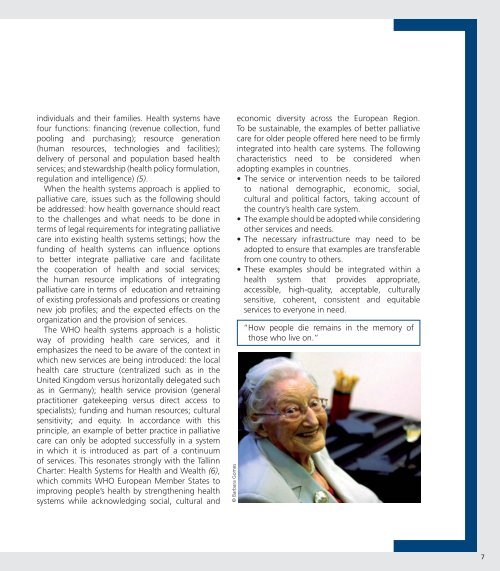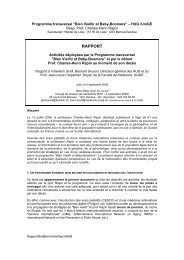2<strong>Palliative</strong> <strong>care</strong>What is palliative <strong>care</strong>?WHO (1) has defined palliative <strong>care</strong> as:“…an approach that improves the quality of lifeof patients and their families facing the problemassociated with life-threatening illness, throughthe prevention and relief of suffering by means ofearly identification and impeccable assessment andtreatment of pain and other problems, physical,psychosocial and spiritual. <strong>Palliative</strong> <strong>care</strong>:…• affirms life and regards dying as a normal process;• intends neither to hasten nor to postpone death;[and]• uses a team approach to address the needs ofpatients and their families, including bereavementcounselling if indicated.…”Since Cicely Saunders (photograph) foundedthe modern hospice movement, the numbersof specialist palliative <strong>care</strong> services, physiciansand nurses (those who have accredited palliative<strong>care</strong> training) have continually increased acrossEurope (2).However, the number and scope of servicesavailable in countries vary widely, and specialistpalliative <strong>care</strong> often does not reach <strong>older</strong> <strong>people</strong>. Forexample, in the United Kingdom, where palliative<strong>care</strong> is well developed, the chance of dying in aninpatient hospice declines with age (3).There is a general move towards offeringgeneralist palliative <strong>care</strong>, which can be delivered byhealth and social <strong>care</strong> professionals, such as staffworking in primary <strong>care</strong> or in <strong>care</strong> homes <strong>for</strong> <strong>older</strong><strong>people</strong>, often aided by staff more specialized inpalliative <strong>care</strong>. Whether palliative <strong>care</strong> is specialist orgeneralist, services need to be integrated into health<strong>care</strong> delivery systems to be sustainable.Isn’t palliative <strong>care</strong> just good health <strong>care</strong>?All the fields of health <strong>care</strong> that provide holistic<strong>care</strong> <strong>for</strong> <strong>people</strong> with chronic illness are increasinglyrecognizing the wider needs of <strong>older</strong> <strong>people</strong>and their families. <strong>Palliative</strong> <strong>care</strong> has focused oncontrolling pain and other symptoms, definingneeds around <strong>people</strong> receiving <strong>care</strong> and theirfamilies and being flexible about doing what isnecessary to help <strong>people</strong> adapt and cope withtheir situation. The concept that palliative <strong>care</strong> isrelevant only to the last few weeks of life (whenno other treatment is beneficial) is outdated.People needing <strong>care</strong> and their families experiencemany problems throughout the course of an illnessand need help, especially when problems changeor become complex. A more appropriate conceptis there<strong>for</strong>e that palliative <strong>care</strong> is offered from thetime of diagnosis, alongside potentially curativetreatment, to disease progression and the end of life.<strong>Palliative</strong> <strong>care</strong> is a component of health <strong>care</strong> that canbe needed at any time in life, starting at a low baseand rising to eventually become the predominanttheme <strong>for</strong> many <strong>people</strong> (4).The WHO health systems approach<strong>Health</strong> systems have three goals: to improve thehealth status of the population (both the averagelevel of health and the distribution of health); toimprove fairness of financing (financial protectionand equitable distribution of the burden of fundingthe system); and to improve responsiveness tothe non-medical expectations of the population,including two sets of dimensions, respect <strong>for</strong><strong>people</strong> (patient dignity, confidentiality, autonomyand communication) and client orientation (promptattention, basic amenities, social support andchoice). <strong>Palliative</strong> <strong>care</strong> is especially relevant to thelatter because it is concerned with the psychosocialaspects of <strong>care</strong>, dignity and quality of life of6
individuals and their families. <strong>Health</strong> systems havefour functions: financing (revenue collection, fundpooling and purchasing); resource generation(human resources, technologies and facilities);delivery of personal and population based healthservices; and stewardship (health policy <strong>for</strong>mulation,regulation and intelligence) (5).When the health systems approach is applied topalliative <strong>care</strong>, issues such as the following shouldbe addressed: how health governance should reactto the challenges and what needs to be done interms of legal requirements <strong>for</strong> integrating palliative<strong>care</strong> into existing health systems settings; how thefunding of health systems can influence optionsto better integrate palliative <strong>care</strong> and facilitatethe cooperation of health and social services;the human resource implications of integratingpalliative <strong>care</strong> in terms of education and retrainingof existing professionals and professions or creatingnew job profiles; and the expected effects on theorganization and the provision of services.The WHO health systems approach is a holisticway of providing health <strong>care</strong> services, and itemphasizes the need to be aware of the context inwhich new services are being introduced: the localhealth <strong>care</strong> structure (centralized such as in theUnited Kingdom versus horizontally delegated suchas in Germany); health service provision (generalpractitioner gatekeeping versus direct access tospecialists); funding and human resources; culturalsensitivity; and equity. In accordance with thisprinciple, an example of better practice in palliative<strong>care</strong> can only be adopted successfully in a systemin which it is introduced as part of a continuumof services. This resonates strongly with the TallinnCharter: <strong>Health</strong> Systems <strong>for</strong> <strong>Health</strong> and Wealth (6),which commits WHO European Member States toimproving <strong>people</strong>’s health by strengthening healthsystems while acknowledging social, cultural and© Barbara Gomeseconomic diversity across the European Region.To be sustainable, the examples of better palliative<strong>care</strong> <strong>for</strong> <strong>older</strong> <strong>people</strong> offered here need to be firmlyintegrated into health <strong>care</strong> systems. The followingcharacteristics need to be considered whenadopting examples in countries.• The service or intervention needs to be tailoredto national demographic, economic, social,cultural and political factors, taking account ofthe country’s health <strong>care</strong> system.• The example should be adopted while consideringother services and needs.• The necessary infrastructure may need to beadopted to ensure that examples are transferablefrom one country to others.• These examples should be integrated within ahealth system that provides appropriate,accessible, high-quality, acceptable, culturallysensitive, coherent, consistent and equitableservices to everyone in need.“How <strong>people</strong> die remains in the memory ofthose who live on.”7
















